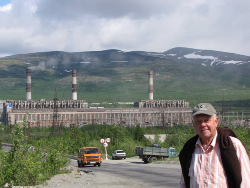
Image: The smelter at Apatity with the author (Glasby) pictured in the foreground. The smelter complex extends a long way into the background. Only the smelter on the left is in action.
Phosphate deposits of the Kola Peninsula, Arctic Russia, are an important resource for the future, say Yuri Voytekhovsky* and Geoff Glasby FGS
Geoscientist 21.07 August 2011
In the Khibiny Mountains of northern Russia between 1923 and 1925, the great Soviet geochemist A E Fersman
1 and colleagues discovered large apatite (calcium phosphate) deposits. Exploitation began in 1929, and has been a major industry ever since. In 1934, two million tonnes (Mt) of apatite-nepheline rocks were being mined each year as source material for fertilizers. Currently, two major mining groups exploit these huge deposits; Kovdor GOK OAO and Apatit OAO, and in 1990, apatite ore reserves were estimated to be in excess of 828Mt. Present evidence suggests that the phosphate industry in the aptly named city of Apatity has at least another 50 years of life left in it.
The Kola Peninsula, where the Khibiny Mountains stand, is one of Russia’s most important sources of economic minerals, with deposits of iron, copper-nickel, other non-ferrous and rare metals, phosphate, mica, clays, and many other types of minerals
2.The Kola Peninsula is perhaps best known among geologists for the Kola Superdeep Borehole (SG-3), a massive Soviet science project that drilled to a depth of 12,261m between 1970 and 1984. This was the only time that a borehole has penetrated to such a depth, 1km deeper than the Marianas Trench
3. Drilling to such a depth in the Earth’s crust has never been repeated.
However the geoscientific history of the region really began with Fersman and the building, in 1929, of the first railhead. A site was chosen for a future town around the projected mines. Enrichment plants were constructed and the townships of Apatity and Kirosk founded. Bringing ore deposits of this magnitude into play in this remote region posed huge logistical problems; and yet only five years after the foundation of an industrial combine in 1929, the infrastructure of processing plants necessary to process these deposits was all in place.
The Khibiny complex is the largest alkaline intrusion in the world with an area of 1327 km
2 and is centred on 67° 52'N and 33° 35'E It is essentially a ring complex some 40km in diameter composed of nepheline syenites, which are divided into several types mainly on the basis of textural and structural features
3. Eight intrusive phases have been recognised. The complex consists of a central ring of melteigite-urtite, which is younger than the main nepheline syenites and was emplaced along major faults at 360-380Ma. Lenses rich in apatite occur within the urtite.
Six of these lenses are presently mined in enormous open-cast pits or in underground mines where the near surface ores are exhausted. Normally about 11Mt of ore are mined from these deposits each year. This constitutes about 8% of total world phosphate production. However, output declined by almost 20% in the first quarter of 2009 as a result of the world recession and production of nepheline concentrate ceased when its only customer, the Pikalevsk Alumina Refinery Plant, was closed. Nonetheless, if one visits the Apatity phosphate plant today, one will see trains each of 30 large carriages exporting phosphate ore several times a day.